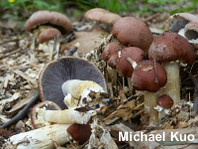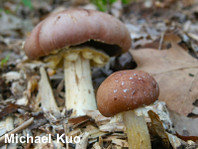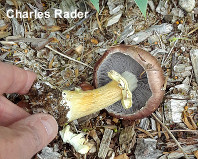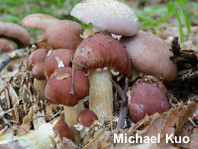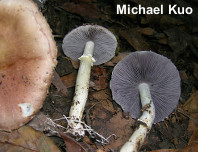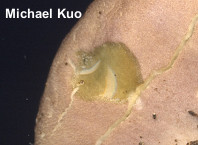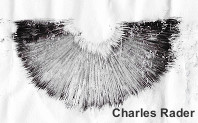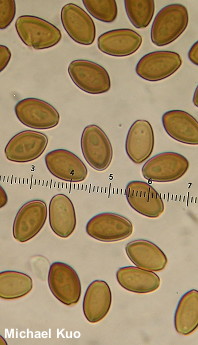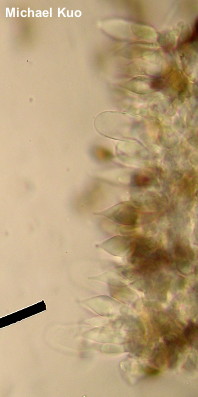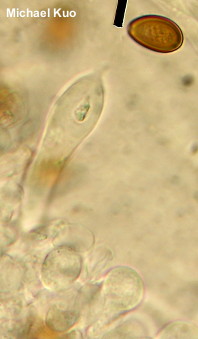| Major Groups > Gilled Mushrooms > Dark-Spored > Stropharioid Mushrooms > Stropharia rugosoannulata |

|
Stropharia rugosoannulata [ Basidiomycota > Agaricales > Strophariaceae > Stropharia . . . ] by Michael Kuo This beautiful mushroom is easily recognized by its preference for woodchips and other urban habitats, its purple-gray gills and spore print, and its distinctive ring, which is thick, finely lined on the upper side, and radially split or "cogwheeled" on the underside. Fresh caps are wine red to reddish brown, but they often fade to yellowish brown. A white form also occurs; I have treated it separately. I was searching rather fruitlessly for morels in Pennsylvania when a woman, out for a walk on the woodchip trail that borders my morel spot, asked what I was looking for. When I said "mushrooms," she replied, "What's wrong with these over here?" Stropharia rugosoannulata wasn't exactly what I had in mind that day, but the large clusters of mushrooms were, I had to admit, impressive. Moments later a troop of girl scouts came marching down the trail (I'm not making this up), shepherded by a very stern woman who lectured them about how fragile the forest ecosystem was, and how they should never stray from the trail or tromp around on things. There were many disapproving looks in my direction, though I tried to slip behind a large tulip tree. As the troop faded away in a haze of woodchip-directed backpacks, cell phones, and giggles, I was left to wonder whether my mushroom collecting could be as invasive as plowing up miles of trails through the woods and covering them with non-native woodchips (and all their attendant mycelia and microbes)—and to wonder why my students hate walking in the woods . . . Thanks to Charles Rader for collecting, documenting, and preserving Stropharia rugosoannulata for study; his collection is deposited in The Herbarium of Michael Kuo. Description: Ecology: Saprobic; growing scattered or gregariously (sometimes in clusters); usually found on woodchips, in gardens, and in other cultivated areas, but sometimes collected along stream beds where spring floods have occurred; spring through fall; in North America widespread and fairly common east of the Great Plains, and occasionally reported in Washington and British Columbia. The illustrated and described collections are from Pennsylvania, Massachusetts, and Illinois. Cap: 4–13 cm; convex at first, becoming broadly convex to nearly flat; sticky when fresh, but soon glossy and dry; bald; wine red to reddish brown, fading to yellowish brown or yellowish; sometimes developing cracks in old age; the margin sometimes hung with ragged partial veil remnants. Gills: Attached to the stem; close or nearly crowded; short-gills frequent; whitish to pale gray at first, becoming purplish gray to purple-black. Stem: 8–16 cm long; 1–2 cm thick; equal, or with an enlarged base; dry; bald or finely hairy; white, discoloring yellowish to brownish in age; usually featuring a thick, white to yellowish ring that is finely grooved on its upper surface (and often blackened by spores) and radially split or "cogwheeled" on its underside; base with white mycelial threads. Flesh: White; firm; unchanging when sliced. Odor and Taste: Not distinctive. Spore Print: Dark purple-brown to purplish black. Chemical Reactions: KOH on cap surface olive green. Microscopic Features: Spores 11–15 x 7–9 µm; ellipsoid, with one end slightly truncated for a large pore measuring 1-2 µm across; smooth; thick-walled; yellow-brown in KOH. Basidia 4-sterigmate. Cheilocystidia dimorphic: either 25–45 x 7.5–15 µm, fusoid-ventricose, often becoming rostrate, thin-walled, smooth, hyaline in KOH, often but not always developing globular, refractive inclusions and becoming chrysocystidia—or 35–50 x 12.5–15 µm, widely cylindric to subutriform, thin-walled, smooth (leptocystidia). Pleurocystidia similar to chryso-cheilocystidia. Pileipellis a slightly gelatinized cutis of elements 5–15 µm wide; elements smooth, hyaline to orangish brown in KOH; terminal cells cylindric with rounded apices. REFERENCES: Farlow ex Murrill, 1922. (Stamets, 1978; Smith, Smith & Weber. 1979; Arora, 1986; Phillips, 1991/2005; Lincoff, 1992; Noordeloos, 1999; Roody, 2003; McNeil, 2006; Miller & Miller, 2006; Kuo & Methven, 2014.) Herb. Kuo 05080306, 08300403, 05301701. This site contains no information about the edibility or toxicity of mushrooms. |
© MushroomExpert.Com |
|
Cite this page as: Kuo, M. (2017, December). Stropharia rugosoannulata. Retrieved from the MushroomExpert.Com Web site: http://www.mushroomexpert.com/stropharia_rugosoannulata.html |
